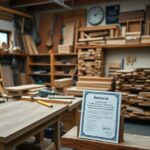You might be passionate about woodworking, but your workshop carries inherent risks that can impact both your safety and financial security.
Whether you’re a hobbyist or professional woodworker, your daily operations involve powerful machinery, sharp tools, and potentially hazardous materials that pose various risks.
From accidents and injuries to property damage and liability issues, understanding these risks and securing appropriate insurance coverage can protect your investment and ensure your woodworking activities continue smoothly, even when unexpected incidents occur.
Physical Hazards in Woodworking
To work safely in your woodworking shop, you need to understand and address various physical hazards that can impact your well-being.
Your workshop environment presents multiple risks, from heavy machinery and sharp tools to airborne particles and repetitive motions.
Recognizing these hazards allows you to implement proper safety measures and maintain appropriate insurance coverage.
Machine-Related Injuries
After setting up your power tools, you face risks from rotating blades, moving parts, and high-speed cutting surfaces.
Your fingers, hands, and arms are particularly vulnerable to injuries from table saws, routers, and planers. Even with proper training, accidents can occur due to kickback, material splitting, or momentary lapses in concentration.
Respiratory Risks
An often overlooked danger in your woodworking shop comes from airborne particles, including wood dust, finishes, and chemical vapors.
Your lungs can be severely affected by prolonged exposure to these particles, leading to respiratory issues and potential long-term health complications.
Respiratory protection should be a standard part of your woodworking safety equipment. Your exposure to different wood species can trigger varying levels of respiratory response, from mild irritation to severe allergic reactions. Installing proper ventilation systems and using appropriate dust collection equipment helps minimize these risks, but you should still maintain adequate insurance coverage for potential health-related claims.
Workshop Safety Measures
One of your primary responsibilities as a woodworker is to maintain a safe workshop environment. By implementing proper safety protocols, you can significantly reduce the risk of accidents and injuries.
Your commitment to safety not only protects you and others but also helps maintain lower insurance premiums.
Personal Protective Equipment
About 90% of workshop injuries could be prevented with proper protective gear. Your crucial PPE kit should include safety glasses, hearing protection, dust masks, and steel-toed boots.
When working with power tools, you need to wear close-fitting clothes and remove any jewelry or accessories that could get caught in machinery.
Workspace Organization
Against the backdrop of potential hazards, your workshop layout demands careful planning. You should maintain clear pathways, proper tool storage, and adequate lighting.
Your work surfaces need to remain clean and clutter-free, while power tools require designated spaces with appropriate clearance zones.
In addition to basic organization, you should establish specific zones for different activities. Your cutting area needs to be separate from assembly spaces, and your finishing area requires proper ventilation. By maintaining this systematic approach, you can minimize cross-contamination and reduce the risk of accidents caused by overlapping activities.
Fire and Property Risks
After setting up your woodworking shop, you need to understand that wood processing creates multiple fire hazards.
Your workspace contains highly flammable materials, including wood dust, finishing products, and various chemicals.
To protect your investment, you’ll need comprehensive property insurance that covers fire damage, equipment replacement, and business interruption costs.
Dust Accumulation Dangers
For your safety, you must recognize that wood dust accumulation poses a serious fire risk. When fine dust particles become airborne and reach certain concentrations, they can ignite from even the smallest spark. Your regular cleaning schedule should include removing dust from surfaces, rafters, and electrical fixtures to minimize this risk.
Electrical Hazards
Accumulation of sawdust around electrical equipment in your workshop creates a dangerous combination. Your power tools, extension cords, and electrical panels can generate heat and sparks that may ignite nearby dust particles. You’ll need to maintain clear spaces around all electrical components and regularly inspect your wiring.
This risk extends beyond simple dust concerns. Your electrical system faces constant stress from power tool usage, and damaged cords or overloaded circuits can create fire hazards.
You should implement a regular maintenance schedule for all electrical components and consider installing specialized dust-proof electrical fixtures in your workshop.

Essential Insurance Coverage
Once again, protecting your woodworking business requires a comprehensive insurance strategy. As a woodworker, you need coverage that addresses both common and industry-specific risks.
Your insurance portfolio should include protection against accidents, property damage, and equipment breakdown to ensure your business can continue operating smoothly even when unexpected events occur.
General Liability Insurance
Insurance for your woodworking business starts with general liability coverage. This policy protects you from third-party claims involving bodily injury, property damage, and personal injury that may occur during your operations.
Your coverage extends to incidents both at your workshop and at client locations, including accidents from finished products after delivery.
Professional Equipment Coverage
At the heart of your woodworking operation lies valuable machinery and tools that need specific protection.
Professional equipment coverage safeguards your investments in table saws, planers, routers, and other specialized tools against theft, damage, and mechanical breakdown.
Consequently, your equipment coverage should reflect the full replacement value of your tools and machinery. You can customize your policy to include coverage for portable equipment used at different job sites, rental equipment, and even tools owned by your employees when used for business purposes.
This protection ensures you can quickly replace or repair necessary equipment without significant financial strain.
Workshop-Specific Policies
For your woodworking business, standard insurance policies may not provide adequate coverage for specialized equipment and unique risks.
Workshop-specific policies offer tailored protection addressing the distinct challenges of woodworking operations, including coverage for your expensive machinery, custom tools, and specialized safety equipment.
Business Interruption Insurance
Policies that protect your income stream when unexpected events force your workshop to temporarily close are crucial for financial stability.
This coverage helps you meet ongoing expenses, maintain employee payroll, and recover lost profits during downtime caused by covered incidents like fire, equipment breakdown, or natural disasters.
Workers’ Compensation
Below certain employee thresholds, you might think workers’ compensation insurance is optional. However, in most states, you need this coverage as soon as you hire your first employee, protecting both your business and your workers from workplace injuries.
But you should also consider that workers’ compensation requirements vary by state and the size of your operation.
Your policy needs to cover medical expenses, rehabilitation costs, and lost wages for employees injured while operating woodworking machinery or handling materials in your workshop.
Risk Assessment Methods
All woodworking operations require systematic evaluation of potential hazards in your workshop. You need to identify risks associated with machinery, tools, materials, and work processes.
Your assessment should cover both obvious dangers like sharp blades and subtle risks such as dust exposure or repetitive motion injuries.
Regular documentation and updates of these assessments help you maintain a safer working environment.
Safety Audits
By conducting regular safety audits, you can maintain optimal workshop safety standards. Your audit checklist should include inspection of equipment guards, emergency stops, ventilation systems, and personal protective equipment.
These systematic reviews help you identify potential hazards before they lead to accidents and ensure your workshop meets current safety regulations.
Emergency Protocols
Among the crucial components of your workshop safety plan, emergency protocols deserve special attention.
Your emergency response procedures must cover scenarios from minor injuries to major accidents.
You should clearly post emergency contact numbers, first aid stations, and evacuation routes throughout your workshop.
Safety protocols require your team to practice emergency drills regularly. You should maintain fully stocked first aid kits, ensure clear access to emergency exits, and keep fire extinguishers in easily accessible locations.
Your emergency plan should also include specific procedures for different types of accidents, from machine-related injuries to chemical exposures.
To wrap up
Summing up, your woodworking passion comes with inherent risks that can impact both your safety and financial stability.
By understanding common hazards like kickback injuries, chemical exposure, and equipment damage, you can take proactive steps to protect yourself.
Having comprehensive insurance coverage, including personal liability, equipment, and workshop insurance, provides you with vital protection against unexpected accidents and losses.
When you secure the right insurance solutions, you can focus on your craft with greater peace of mind, knowing you’re protected against woodworking’s most significant risks.







